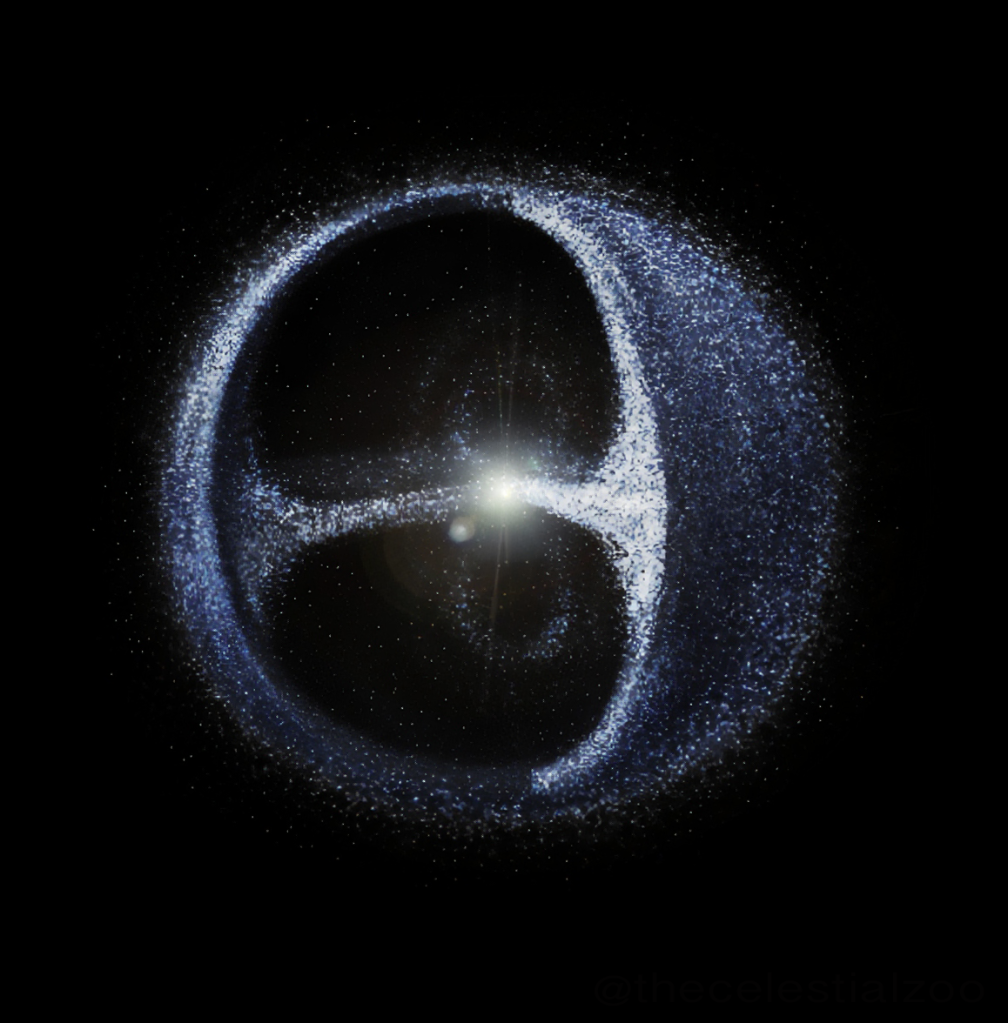At the edge of the Sun’s gravitational influence, there’s a cloud of ice and rock. Probably.
Every system needs a boundary, and the Solar System is no different. Although we haven’t been able to physically reach and see it, we have a theory about what this edge looks like. And its name is the Oort cloud.

Ask anyone on the street where the Solar System ends, and they’re likely to mention Pluto. To a certain extent, it wouldn’t be wrong; Pluto really is the farthest planet / dwarf planet from the Sun. But if we want to be all sciency about it — and we do — the Solar System arguably ends where our star’s gravitational influence becomes too weak to capture and hold objects. In other words, it spans over all the space where the Sun is the dominating tidal force (Smoluchowski, Torbett, 1984). Exactly what constitutes the edge of the Solar System is still up to some debate, however, and some sources — including this post by NASA — consider the space beyond the heliosphere as being ‘interstellar space’.
For the purposes of this post, however, we’ll take the volume where the Sun’s gravity reigns supreme as being the Solar System. The point where that influence ends is far, far away from Earth. So far away, in fact, that we’ve never been able to actually see it, and, realistically speaking, there’s no way humanity will reach there while any of us reading this are still alive. But we do have some theories regarding what goes on out there.
The boundary of the Solar System is marked by a hypothetical structure known as the Oort cloud. We estimate that it is a truly vast expanse filled with varied clusters of ice, from innumerable tiny chunks up to a few billion planetesimals of around 20 kilometers (12 mi) in diameter. There are likely a few rocky or metallic asteroids here, as well, but not many in number. The material in the Oort cloud was likely drawn to its current position through the gravitational influence of the gas giants — Jupiter, Saturn, Neptune, and Uranus — in the early days of the Solar System.
So what is it?
The thing to keep in mind here is that the Oort cloud is a hypothetical structure. We haven’t yet seen it, nor do we have any direct evidence of it being real. But its existence would fit with other elements and phenomena we see in the Solar System, and it does fit our theoretical understanding of the world around us, as well.
The Oort cloud is a vast body. Since it’s a theoretical structure, there’s quite a bit of uncertainty in our estimates of its size. Still, we believe it stretches from around 0.03 to 0.08 light-years from the Sun, although other estimates put its outer boundary at 0.8 light-years from the Sun. There are also estimates that place it between 1.58 and 3.16 light-years away from the Sun. Needless to say, we don’t have a good handle on exactly where it is, and how large it is.
“It is like a big, thick-walled bubble made of icy pieces of space debris the sizes of mountains and sometimes larger. The Oort Cloud might contain billions, or even trillions, of objects, ” NASA explains.
But to give you a rough idea of the distances involved, however, we’ll use Voyager 1, the fastest-going probe we’ve ever sent to space, and the one currently farthest away from Earth. On its current course and acceleration, Voyager 1 would reach the Oort cloud in around 300 years; it would take it some 30,000 years to pass through the cloud (depending on its actual dimensions).

Still, don’t get too excited. None of the space probes humanity has launched so far will still be operational by the time they reach the Oort cloud; despite being powered by RTGs, a type of nuclear battery, all of these crafts will run out of power far before they reach the Oort clour.
Why do we think it’s a thing?
The concept of the Oort cloud was first suggested in the 1930s by Estonian astronomer Ernst Öpik. The idea was cemented in the 1950s when its existence was independently suggested a second time by Jan Oort, a Dutch astronomer. Because of this dual origin, it is sometimes referred to as the Öpik–Oort cloud.
The existence of this cloud was proposed mainly due to comets — long-period and Halley-type comets, to be precise. Since comets coming close to the Sun lose part of their volatile contents (for example water) under the influence of solar radiation, logic dictates that they must form away from the star. At the same time, gravitational influences would see them either collide with a planet or star or be ejected from the Solar System eventually — meaning that their ‘lifespan’ is limited. Since there are still comets zipping around the Sun, this means that there must be a reservoir of comets to be drawn towards our star.
Put together, both of these point to the existence of a cloud-like formation at the very edge of the Sun‘s gravitational influence populated with comet-like bodies — the Oort cloud.
Short-period comets orbit around the Sun every few hundreds of years; because of this short time, it’s generally accepted that they originate from structures closer to Earth, such as the Kuiper belt (a field of asteroids extending past Neptune). Long-period comets, however, can have orbits lasting thousands of years. The only source that could explain such huge spans of time is the Oort cloud. One exception to these rules is Halley-type comets. Although they are short-period comets, we believe they’re originally from the Oort cloud and that they’ve been pulled ever closer to the center of the Solar System under the gravitational effects of the Sun and inner planets.
What are we doing to study it?
The main impediment to our studying of the Oort cloud is distance. It’s simply too far away for our spaceships or probes to reach in any practical manner. There also haven’t been any direct observations of the Oort cloud.
Despite this, its existence is widely accepted in academic circles. Researchers rely on indirect methods of study to peer into the secrets of the Oort cloud. These revolve heavily around the study of comets and their properties. There is also a lot of effort being poured into developing devices and methods that can be used to spot individual bodies inside the Oort cloud. This is no easy feat, as they’re quite tiny by cosmological standards, and very far away.
Once we do have such tools at our disposal, however, astronomers will finally be able to confirm whether the Oort cloud actually exists. It’s very likely that it does, and it would fit with our current understanding of the Universe. But until we can see it, we won’t be able to tell for sure
Posted by Technical Mechzone

